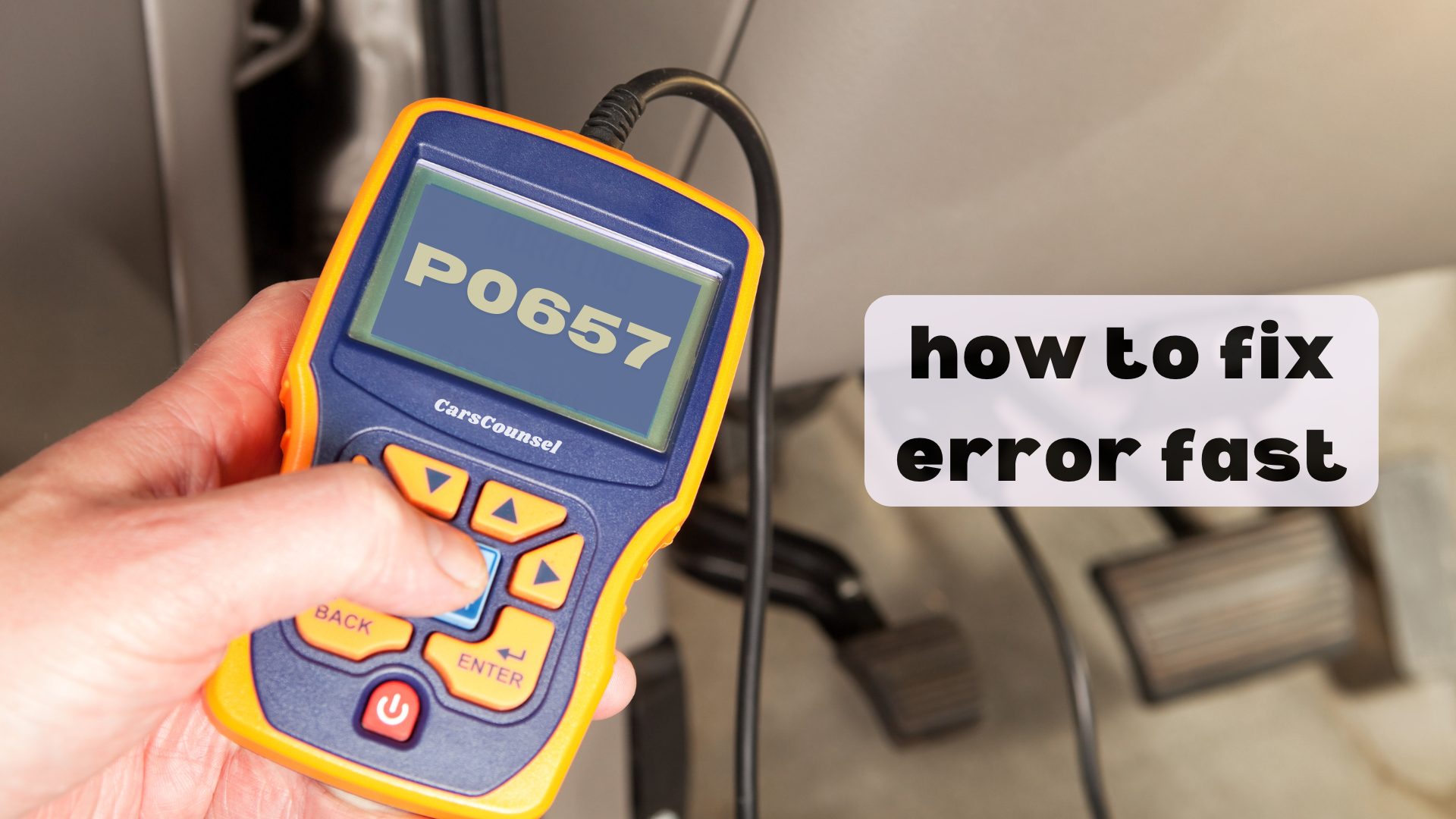Dealing with a P0657 code can be annoying, but you can fix it quickly if you follow the right steps.
Start by using an OBD-II scanner to confirm the trouble code.
Next, take a look at the wiring and connectors to see if there’s any damage or rust.
Also, use a multimeter to check the alternator and battery to make sure they’re working correctly.
If you find any sensors that aren’t working, replace them as soon as possible.
Still having trouble after doing all this? Keep reading to learn more about how to solve this issue.

Quick Navigation
Key Takeaways
- Use a Code Reader: Verify the P0657 code and look for any other related codes.
- Check and Fix Wiring: Look for any damaged or corroded wires and connectors. Repair them as needed.
- Test and Replace Sensors: Make sure the throttle position sensors are working correctly. Replace them if they are not.
- Check Alternator and Battery Voltage: Use a multimeter to check the voltage of the alternator and battery.
What Is the P0657 Code?
What Is the P0657 Code?
The P0657 code shows there’s a problem with the voltage signal from the alternator‘s A circuit and a fault in the engine control module (ECM). Understanding this code means knowing that the voltage isn’t within the normal range, which often hints at issues with sensors or wiring.
To troubleshoot the P0657 code, start by using an OBD-II scanner to confirm the code. Then, check the alternator and battery with a multimeter. Also, inspect the wiring and connectors for any damage or corrosion.
Proper diagnostics and timely repairs can prevent bigger problems like engine issues or higher fuel consumption, keeping your vehicle running smoothly.
Symptoms of P0657 Code
When you get a P0657 code, you might see several signs that something’s wrong with your car. These can include:
- The check engine light turning on
- The engine not running as well as it should
- More fuel being used than usual
These issues often point to electrical problems that need to be fixed right away. You might find that your car has trouble speeding up or that it uses more gas, which can be costly over time.
| Symptom | Description | Impact |
|---|---|---|
| Check Engine Light | Light on your dashboard is lit | Needs immediate check-up |
| Poor Engine Performance | Slower acceleration and power | Makes driving harder |
| Increased Fuel Consumption | Using more gas than normal | Expensive in the long run |
Noticing these signs early can help you fix the problem faster.
Why P0657 Code Appears
The P0657 code shows up when there’s a problem with the voltage signal from the alternator’s A circuit. This can happen because of bad sensors, damaged wiring, or issues with the engine control module (ECM).
If the voltage signal isn’t in the right range, the P0657 code gets triggered. Damaged wiring or connectors can cause the voltage to fluctuate.
Faulty sensors, like the throttle position sensor, can also mess up these voltage signals. Things like moisture can make sensor problems worse.
The ECM might also be failing and giving wrong voltage readings. Fixing these issues quickly helps keep your car running well and avoids bigger engine problems.
Faulty Alternator Issues
A bad alternator can cause your car’s electrical systems to act up because it won’t generate enough voltage. To fix this, start by testing the alternator. Use a multimeter and check the voltage output. When the engine is running, it should read between 13.5 and 14.5 volts. If it doesn’t, you probably need a new alternator.
Here’s a simple guide:
| Task | Tool Needed |
|---|---|
| Test Alternator | Multimeter |
| Check Voltage | Voltage Tester |
| Inspect for Issues | Flashlight |
Make sure the alternator connections are tight and not corroded. Regular checks can help prevent voltage problems and avoid the P0657 error code. Always be safe when working with electricity.
Battery Problems and P0657
If your alternator is working fine, the next thing to check for the P0657 code is often a bad battery that can’t hold a charge.
Start by testing the battery with a multimeter to measure the voltage. A fully charged battery should read around 12.6 volts. If the reading is much lower, you need to replace the battery.
Regularly cleaning the terminals and making sure the connections are secure can help prevent problems. Look for signs of corrosion or loose wires, as these can affect how well the battery works.
Keeping your battery in good shape ensures it won’t put extra strain on the alternator, which helps avoid the P0657 code. Always make battery health a priority in your vehicle maintenance.
Wiring and Connector Damage
Wiring and connector damage can often cause voltage signals to fluctuate and set off the P0657 code. To address this, you need to check for corroded or damaged wires and ensure the connectors are in good condition. Damaged or corroded wires can mess with the electrical signal, leading to voltage problems. Here’s what to do:
- Look Over the Wires: Check for any signs of corrosion or wear.
- Check the Wiring: Use a multimeter to see if there are any breaks.
- Inspect Connectors: Make sure the connectors are clean and properly secured.
| Step | Tool Needed | Key Focus |
|---|---|---|
| Look Over the Wires | Flashlight | Wiring corrosion |
| Check the Wiring | Multimeter | Signal flow |
| Inspect Connectors | Socket Set | Connector integrity |
| Replace Components | Wire Crimpers | Damaged wiring |
PCM and BCM Failures
PCM and BCM problems aren’t very common, but they can still cause the P0657 code. You’ll need to test these modules thoroughly and might have to replace them.
For PCM issues, check for any error codes that could indicate problems within the Powertrain Control Module. Problems with the BCM often involve the Body Control Module sending incorrect electrical signals, which can mess with how the vehicle runs.
First, use an OBD-II scanner to find any related codes. Check and test the PCM and BCM to make sure they’re working right. If you find any issues, you might need to replace these modules.
Also, look for any software updates that could fix the problem without needing new hardware. After making any repairs, take the car for a test drive to make sure the P0657 code is gone.
Sensor Malfunctions
When sensors have problems, they often mess with voltage signals, causing the P0657 code to pop up. Faulty sensors send wrong data to the car’s computer, which leads to voltage issues.
Here’s how to fix it:
- Calibrate Sensors: Make sure the sensors are set up right to give accurate readings.
- Replace Sensors: If calibration doesn’t work, swap out the bad sensor for a new one.
- Check Wiring: Look at the sensor wiring for any damage or rust that might mess with the signals.
- Check Sensor Grounds: Ensure all sensor grounds are tight and not rusty or worn out.
Fixing sensor problems quickly will help clear the P0657 code and keep your car running well. Always use good-quality sensors and follow the manufacturer’s instructions for setting them up and installing them.
Diagnostic Tools for P0657
To diagnose sensor issues and clear the P0657 code, you’ll need tools like an OBD-II scanner and a multimeter.
Start by connecting the OBD-II scanner to get trouble codes and identify the problem. This scanner reads and shows error codes from your vehicle’s computer.
Next, use a multimeter to check voltage levels. Make sure the battery and alternator have the correct voltage, as specified by the manufacturer.
Also, inspect wiring and connectors for any damage or corrosion.
Using these tools step-by-step will help you find and fix the voltage signal issues causing the P0657 code.
Steps to Fix P0657
Start fixing the P0657 code by making sure you have the right tools and understand the problem clearly. Here’s a simple guide to help you:
- Check the Alternator and Battery: Use a multimeter to measure voltage. If either one is bad, replace it to keep the voltage signal stable.
- Inspect Wiring and Connectors: Look for damaged or corroded wires. Fix or replace them as needed to ensure good connections.
- Test and Replace Faulty Sensors: Check if sensors like the throttle position sensor are working properly. Replace any that are not.
- Update ECM Software: Look for and install any updates to the Engine Control Module to improve how the system works.
These steps will help you fix the P0657 code effectively.
More OBD-II Codes
Frequently Asked Questions
Can Extreme Weather Conditions Trigger the P0657 Code?
Extreme weather can cause the P0657 code to pop up because it can mess with the sensors. Moisture or big temperature changes can make the sensors act up and cause voltage problems. To prevent this, regularly check the sensors and wiring.
How Long Does It Usually Take to Diagnose the P0657 Code?
Imagine popping the hood of your car and grabbing your tools. Figuring out the P0657 error code usually takes about one to two hours. This can vary based on your experience and if you run into any wiring or sensor problems.
Are Aftermarket Parts Reliable for Fixing the P0657 Code?
You can use aftermarket parts to fix the P0657 code, but make sure they’re reliable and good quality. Look up trusted brands and read reviews. Good aftermarket parts can work just as well as original ones for fixing voltage signal problems.
Can Driving With a P0657 Code Cause Further Damage?
Absolutely, you shouldn’t ignore a P0657 code. Driving with this code can make your engine run poorly and could even harm your alternator and battery. It’s best to fix it now to avoid expensive repairs later on.
Is the P0657 Code Covered Under Standard Car Warranties?
Check what your warranty covers and any limits it might have. Manufacturer warranties often handle electrical problems like the P0657 code, but it really depends on how old your car is, how many miles it has, and the terms of your warranty. Always take a look at your warranty documents to be sure.
Conclusion
Think of the P0657 code as a warning light for electrical issues in your car.
Start by scanning for codes, checking the wiring, and testing the voltage.
Replace any faulty sensors, clear the codes, and take a test drive to make sure everything is running smoothly.
With the right steps and tools, you can avoid bigger problems and expensive repairs down the road.

